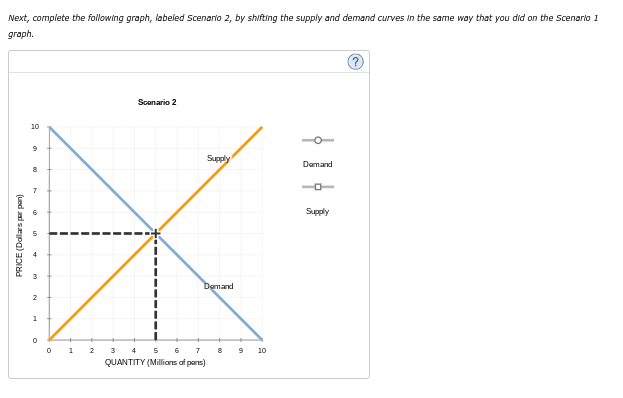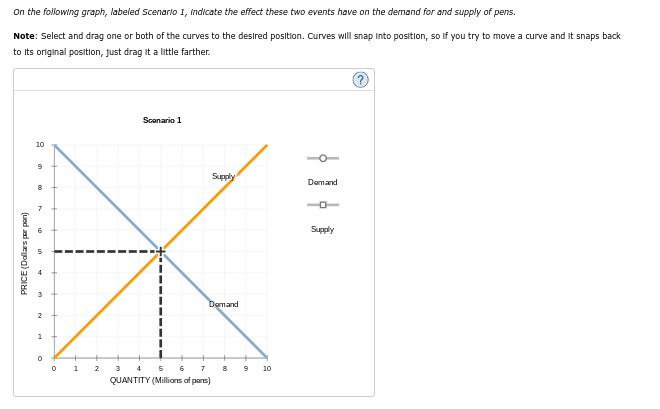Consider the market for pens. Suppose that a new educational study has proven that the practice of writing, erasing, and rewriting improves students' ability to process information, leading parents to steer away from pen use in favor of pencils. Moreover, the price of ink, an important input in pen production, has increased considerably. On the following graph, labeled Scenario 1, indicate the effect these two events have on the demand for and supply of pens. (graph in photo 1) Next, complete the following graph, labeled Scenario 2, by shifting the supply and demand curves in the same way that you did on the Scenario 1 graph. (graph in photo 2) Compare both the Scenario 1 and Scenario 2 graphs. Notice that after completing both graphs, you can now see a difference between them that wasn't apparent before the shifts because each graph indicates different magnitudes for the supply and demand shifts in the market for pens. Use the results of your answers on both the Scenario 1 and Scenario 2 graphs to complete the following table. Begin by indicating the overall change in the equilibrium price and quantity after the shift in demand or supply for each shift-magnitude scenario. Then, in the final column, indicate the resulting change in the equilibrium price and quantity when supply and demand shift in the direction you previously indicated on both graphs. If you cannot determine the answer without knowing the magnitude of the shifts, choose Cannot determine. Scenario 1 Scenario 2 When Shift Magnitudes Are Unknown Price Quantity True or False: When both the demand and supply curves shift, you can always determine the effect on price and quantity without knowing the magnitude of the shifts. a. True b. False
Consider the market for pens. Suppose that a new educational study has proven that the practice of writing, erasing, and rewriting improves students' ability to process information, leading parents to steer away from pen use in favor of pencils. Moreover, the price of ink, an important input in pen production, has increased considerably. On the following graph, labeled Scenario 1, indicate the effect these two events have on the demand for and supply of pens. (graph in photo 1) Next, complete the following graph, labeled Scenario 2, by shifting the supply and demand curves in the same way that you did on the Scenario 1 graph. (graph in photo 2) Compare both the Scenario 1 and Scenario 2 graphs. Notice that after completing both graphs, you can now see a difference between them that wasn't apparent before the shifts because each graph indicates different magnitudes for the supply and demand shifts in the market for pens. Use the results of your answers on both the Scenario 1 and Scenario 2 graphs to complete the following table. Begin by indicating the overall change in the equilibrium price and quantity after the shift in demand or supply for each shift-magnitude scenario. Then, in the final column, indicate the resulting change in the equilibrium price and quantity when supply and demand shift in the direction you previously indicated on both graphs. If you cannot determine the answer without knowing the magnitude of the shifts, choose Cannot determine. Scenario 1 Scenario 2 When Shift Magnitudes Are Unknown Price Quantity True or False: When both the demand and supply curves shift, you can always determine the effect on price and quantity without knowing the magnitude of the shifts. a. True b. False
Managerial Economics: Applications, Strategies and Tactics (MindTap Course List)
14th Edition
ISBN:9781305506381
Author:James R. McGuigan, R. Charles Moyer, Frederick H.deB. Harris
Publisher:James R. McGuigan, R. Charles Moyer, Frederick H.deB. Harris
Chapter3: Demand Analysis
Section: Chapter Questions
Problem 1.3CE
Related questions
Question
Consider the market for pens. Suppose that a new educational study has proven that the practice of writing, erasing, and rewriting improves students' ability to process information, leading parents to steer away from pen use in favor of pencils. Moreover, the price of ink, an important input in pen production, has increased considerably.
On the following graph, labeled Scenario 1, indicate the effect these two events have on the demand for and supply of pens.
(graph in photo 1)
Next, complete the following graph, labeled Scenario 2, by shifting the supply and demand curves in the same way that you did on the Scenario 1 graph.
(graph in photo 2)
Compare both the Scenario 1 and Scenario 2 graphs. Notice that after completing both graphs, you can now see a difference between them that wasn't apparent before the shifts because each graph indicates different magnitudes for the supply and demand shifts in the market for pens.
Use the results of your answers on both the Scenario 1 and Scenario 2 graphs to complete the following table. Begin by indicating the overall change in the equilibrium price and quantity after the shift in demand or supply for each shift-magnitude scenario. Then, in the final column, indicate the resulting change in the equilibrium price and quantity when supply and demand shift in the direction you previously indicated on both graphs. If you cannot determine the answer without knowing the magnitude of the shifts, choose Cannot determine.
|
Scenario 1
|
Scenario 2
|
When Shift Magnitudes Are Unknown
|
|
|---|---|---|---|
| Price | |||
| Quantity |
True or False: When both the demand and supply curves shift, you can always determine the effect on price and quantity without knowing the magnitude of the shifts.
a. True
b. False

Transcribed Image Text:Next, complete the following graph, labeled Scenario 2, by shifting the supply and demand curves in the same way that you did on the Scenario 1
graph.
PRICE (Dollars per pan)
10
9
8
7
2
1
0
0
+
1
2
Scenario 2
Supply
Domand
3 4 5 6
7
QUANTITY (Millions of pens)
8
9
10
Demand
Supply

Transcribed Image Text:On the following graph, labeled Scenario 1, Indicate the effect these two events have on the demand for and supply of pens.
Note: Select and drag one or both of the curves to the desired position. Curves will snap Into position, so if you try to move a curve and it snaps back
to its original position, just drag it a little farther.
PRICE (Dollars par pan)
10
9
8
7
1
0
0
1
2
Scenario 1
3
4
5 6 7
QUANTITY (Millions of pans)
Supply
Domand
60
8
9 10
Demand
Supply
Expert Solution
This question has been solved!
Explore an expertly crafted, step-by-step solution for a thorough understanding of key concepts.
This is a popular solution!
Trending now
This is a popular solution!
Step by step
Solved in 2 steps with 2 images

Knowledge Booster
Learn more about
Need a deep-dive on the concept behind this application? Look no further. Learn more about this topic, economics and related others by exploring similar questions and additional content below.Recommended textbooks for you

Managerial Economics: Applications, Strategies an…
Economics
ISBN:
9781305506381
Author:
James R. McGuigan, R. Charles Moyer, Frederick H.deB. Harris
Publisher:
Cengage Learning

Managerial Economics: A Problem Solving Approach
Economics
ISBN:
9781337106665
Author:
Luke M. Froeb, Brian T. McCann, Michael R. Ward, Mike Shor
Publisher:
Cengage Learning

Managerial Economics: Applications, Strategies an…
Economics
ISBN:
9781305506381
Author:
James R. McGuigan, R. Charles Moyer, Frederick H.deB. Harris
Publisher:
Cengage Learning

Managerial Economics: A Problem Solving Approach
Economics
ISBN:
9781337106665
Author:
Luke M. Froeb, Brian T. McCann, Michael R. Ward, Mike Shor
Publisher:
Cengage Learning